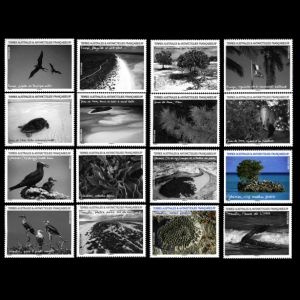the place where Paleontology and Paleoanthropology meets Philately
French Southern and Antarctic Territories (FSAT) /
Terres australes et antarctiques françaises (TAAF) in French
Fossils, continent drift, Paleoclimatology on stamps of TAAF
| << previous country | back to index | next country >> |
Contents:
- Country overview
- Philately of TAAF
- Official stamps of TAAF related to Paleontology
- Some other stamps of TAAF to consider contributors to Paleontology
- References
- Acknowledgements
The French Southern and Antarctic Lands (French: Terres australes et antarctiques françaises, TAAF), in full the Territory of the French Southern and Antarctic Lands is an overseas territory of France. It consists of
- Kerguelen Islands, a group of volcanic islands in the southern Indian Ocean, southeast of Africa, approximately equidistant between Africa, Antarctica and Australia;
- St. Paul and Amsterdam islands, a group to the north of Kerguelen;
- Crozet Islands, a group in the southern Indian Ocean, south of Madagascar;
- Adélie Land, the French claim on the continent of Antarctica;
- The Scattered Islands, a dispersed group of islands around the coast of Madagascar.
From 1906 to 1926, stamps of France were used in the Kerguelen Islands, cancelled by the Resident's cachet. Letters from there are known to have been routed via Madagascar, Cape Town and Durban in South Africa, and Bunbury, Australia. The TAAF was administered from France until 2004. Since then, it has been administered from the Indian Ocean island of Réunion, a French overseas department. Since achieving territorial status it has issued a number of stamps, many of which depict wildlife of the southern oceans and Antarctica, minerals or honour polar explorers and researchers. [R2]
Official stamps of TAAF related to Paleontology: fossils, continent drift, Paleoclimatology
| 01.10.1991 "Climatological Research" [1] | 05.11.2009 "Landscapes" [2] | |
 |
 |
|
Notes:
[1] The right stamp in the issue is dedicated to paleoclimatology research and depicts a research vessel and several examples of foraminifera.
Foraminifera [R3] are single-celled protists that secrete calcium carbonate shells. Oxygen isotopes in Foraminifera shells can be used to reconstruct paleoclimate in ancient times. During glacial intervals, foraminifera shells are enriched in the heavier oxygen-18 isotope.
During interglacial intervals, their shells become enriched in the lighter oxygen-16 isotope. The foraminifera on the left is a planktonic foraminifera that lives in the upper water column.
[2] Booklet with 16 stamps of standard letter rate (0,90€ at the time).
There are two paleontology-related stamps in the set.
The first shows a picture of a fossilized coral reef from the Glorieuses Islands (MiNr.:698, Scot: 420l).
The second shows a fossilized coral colony from Tromelin Island (MiNr.: 701, Scott: 420o).
The Glorieuses Islands and Tromelin Island are French possessions in the Indian Ocean near Madagascar.
Both Tromelin island and the Glorieuses Islands are atolls – islands built up of coral reefs around a volcanic edifice. The fossil coral from Tromelin is a scleractinian coral.
 |


|
Some stamps to consider: contributors to Paleontology
| 01.01.1987 "Ocean drilling program O.D.R." [O1] | 25.06.2022 "Antarctic Explorers" [O2] | |
 |
 |
|
Notes:
[O1] The stamp depicts a plate reconstruction of Pangaea and a ship engaged in scientific drilling in honour of the International Ocean Drilling Program.
[O2] Robert Falcon Scott among other Antarctic Explorers on stamp of TAAF 2022.
References:
- [R1] French Southern and Antarctic Territories: Wikipedia WikiTravel FlagCounter
- [R2] Postal History and Philately of French Southern and Antarctic Territories:
Wikipedia
Links to official website of the Post Authority, stamp catalog and a list of new stamps of French Southern and Antarctic Territories are here - [R3] Foraminifera: Wikipedia,
Acknowledgement:
Dr. Peter Voice from Department of Geological and Environmental Sciences, Western Michigan University, for reviewing the draft page and his valuable comments.
| << previous country | back to index | next country >> |